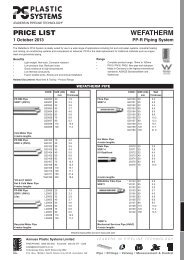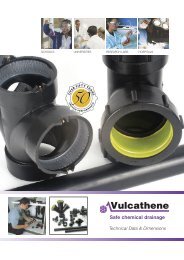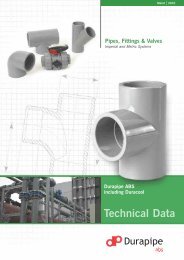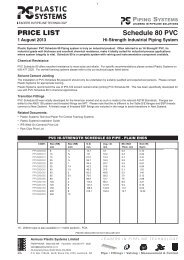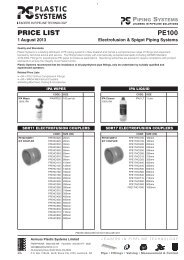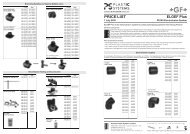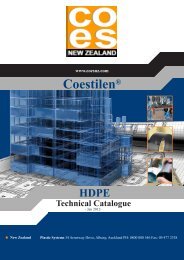Guide to Solvent Cementing PVC and CPVC Plastic ... - Glynwed Asia
Guide to Solvent Cementing PVC and CPVC Plastic ... - Glynwed Asia
Guide to Solvent Cementing PVC and CPVC Plastic ... - Glynwed Asia
You also want an ePaper? Increase the reach of your titles
YUMPU automatically turns print PDFs into web optimized ePapers that Google loves.
SPECIAL PRECAUTIONS<br />
IPS WELD-ON SOLVENT CEMENTS MUST NEVER BE USED IN A <strong>PVC</strong><br />
OR C<strong>PVC</strong> SYSTEM USING OR BEING TESTED BY COMPRESSED AIR<br />
OR GASES! NOTE: Pressurized (compressed) air or other compressed<br />
gases contain large amounts of s<strong>to</strong>red energy which present serious<br />
safety hazards should a system fail for any reason.<br />
Do not use any type of dry granular calcium hypochlorite as<br />
a disinfecting material for water purification in potable water<br />
piping systems. The introduction of granules or pellets of calcium<br />
hypochlorite with <strong>PVC</strong> <strong>and</strong> C<strong>PVC</strong> solvent cements <strong>and</strong> primers<br />
(including their vapors) may result in a violent chemical reaction if a<br />
water solution is not used. It is advisable <strong>to</strong> purify lines by pumping<br />
chlorinated water in<strong>to</strong> the piping system-this solution will be<br />
nonvolatile. Furthermore, dry granular calcium should not be s<strong>to</strong>red<br />
or used near solvent cements <strong>and</strong> primers. All systems should be<br />
flushed before start-up <strong>to</strong> remove excess fumes from piping system.<br />
New or repaired potable water systems shall be purged of<br />
deleterious matter <strong>and</strong> disinfected prior <strong>to</strong> utilization. The method<br />
<strong>to</strong> be followed shall be that prescribed by the health authority<br />
having jurisdiction or, in the absence of a prescribed method, the<br />
procedure described in either AWWA C651 or AWWA C652.<br />
USE CAUTION WITH WELDING TORCHES<br />
At construction sites where plastic pipe is being installed or has<br />
recently been solvent welded, extreme caution should be taken<br />
when using welding <strong>to</strong>rches or other equipment where sparks may<br />
be involved. Flammable vapors from cemented joints sometimes<br />
linger within or around a piping system for some time.<br />
Special care must be taken when using a welding <strong>to</strong>rch in<br />
these installations:<br />
A. Well casing, eleva<strong>to</strong>r shafts <strong>and</strong> other confined areas.<br />
B. Installing pumps in irrigation water lines.<br />
C. <strong>Plastic</strong> pipe systems in industrial plant areas with little<br />
or no air circulation.<br />
In all cases, solvent vapors must be removed by air circulation,<br />
purging, or other means prior <strong>to</strong> the use of welding <strong>to</strong>rches,<br />
or other spark or flame generating equipment or procedures.<br />
19



